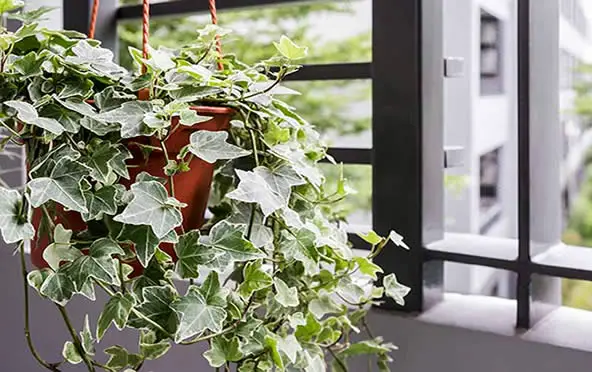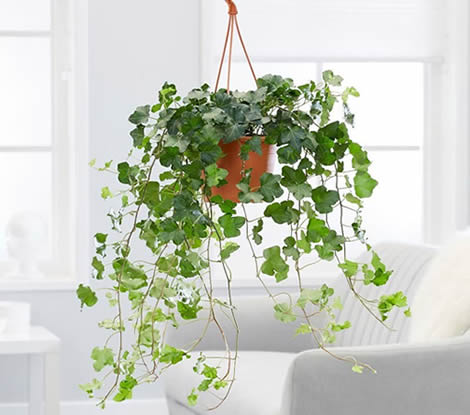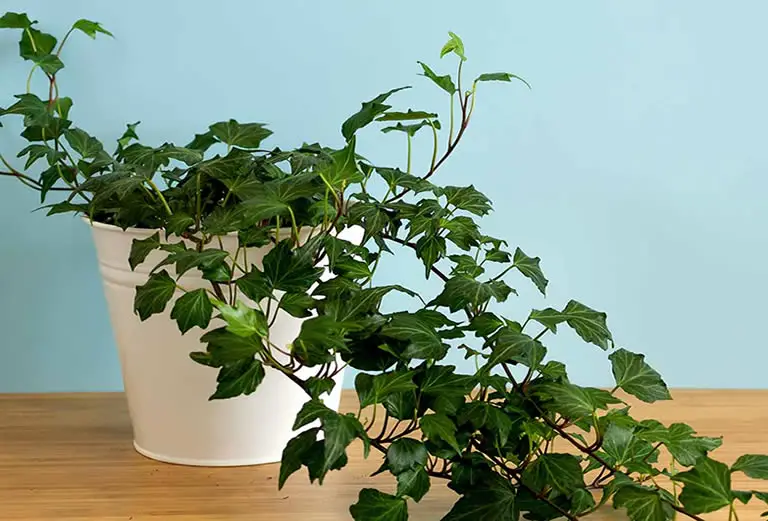English Ivy (Hedera helix) is a timeless favorite with its cascading vines, elegant leaves, and ability to thrive in all kinds of spaces. It adds instant charm to shelves, hanging baskets, or topiary frames, and if you’ve got the right conditions, it’s a vigorous grower that fills out quickly. Indoors, it brings a classic, almost storybook look—and outdoors, it can become a lush, evergreen ground cover.
Here’s how to keep your English Ivy healthy, happy, and under control, whether it’s climbing, trailing, or just softly spilling over the edge of a pot.
Table of Contents
- Cool Light and Crisp Air: What English Ivy Likes Indoors
- Let the Soil Dry Slightly: How to Water Ivy Without Overdoing It
- Cool and Steady: The Ideal Indoor Climate for English Ivy
- Occasional Feeding for Lush Growth: Fertilizer Tips for Ivy
- Tidy Trims and Occasional Repotting: How to Keep Ivy Looking Its Best
- Best Place in the Home: Where English Ivy Looks Great and Grows Well
- Caring for English Ivy Outdoors: A Classic Ground Cover with Caution
- Common English Ivy Problems and How to Fix Them
- Final Thoughts
Cool Light and Crisp Air: What English Ivy Likes Indoors
English Ivy prefers bright, indirect light when grown indoors. It can tolerate medium or even lower light, but growth will slow and variegation may fade.

Avoid strong direct sun through glass, which can scorch the leaves, especially in the afternoon.
If you notice the plant reaching or stretching toward the light, it might need a slightly brighter spot.
Let the Soil Dry Slightly: How to Water Ivy Without Overdoing It
Ivy likes to be watered when the top inch of soil feels dry. It prefers evenly moist soil, but soggy conditions will quickly lead to root rot.
Use a lightweight, well-draining potting mix and never let the pot sit in standing water.
During the winter, let the soil dry a bit more between waterings.
Cool and Steady: The Ideal Indoor Climate for English Ivy
English Ivy enjoys cooler indoor temperatures than many tropical houseplants. Aim for 50°F to 70°F and avoid placing it near heat sources or drafty windows.
It prefers moderate humidity and will appreciate a misting every now and then, especially in dry rooms or during the winter heating season.
Occasional Feeding for Lush Growth: Fertilizer Tips for Ivy
Feed English Ivy once a month during spring and summer with a balanced liquid fertilizer diluted to half strength.
In fall and winter, you can skip feeding altogether. Ivy isn’t a heavy feeder, and too much fertilizer can actually lead to soft, weak growth.
Tidy Trims and Occasional Repotting: How to Keep Ivy Looking Its Best
This plant grows fast when happy, and it benefits from regular pruning to keep it full and compact.
Don’t be afraid to trim long vines or pinch back new growth.
Repotting every couple of years in spring will help refresh the soil and give roots a bit more space to stretch out.
Best Place in the Home: Where English Ivy Looks Great and Grows Well
English Ivy is perfect for bookshelves, kitchen tops, hanging planters, or bathroom windows with indirect light.
It looks beautiful trailing from high shelves or climbing up a small trellis.

Ivy can also be trained into shapes, making it a fun option for decorative topiaries.
Caring for English Ivy Outdoors: A Classic Ground Cover with Caution
English Ivy thrives outdoors in USDA zones 4–9, where it can be used as a ground cover or climber in shady to partially sunny areas.
It’s evergreen in most climates and spreads quickly, so it’s important to plant it where it won’t overwhelm other plants or structures.
Ivy can become invasive if left unchecked, so always monitor its growth and trim back aggressively when needed.
If growing in containers on patios or balconies, use high-quality potting soil and make sure the container has good drainage.
Ivy can tolerate cold winters but may go dormant in freezing conditions.
In warmer climates, it grows year-round and may require frequent trimming to keep it under control.
When moving ivy between indoors and out, acclimate it slowly to the change in temperature and light levels, and inspect for pests before bringing it back indoors.
Common English Ivy Problems and How to Fix Them
Brown or crispy leaf edges often point to dry air or underwatering
Fix it by increasing humidity with misting, checking soil moisture more often, and moving the plant away from heat sources
Yellowing leaves are usually caused by overwatering or poor drainage
Fix it by letting the soil dry more between waterings and ensuring the pot drains well
Leggy or sparse growth may be the result of too little light or not enough pruning
Fix it by moving the plant to a brighter location and pinching back long vines regularly to encourage fuller growth

Sticky residue or black spots on leaves can be a sign of pests like aphids or spider mites
Fix it by rinsing the leaves under lukewarm water and treating with neem oil or insecticidal soap
Fading leaf variegation might indicate too little light
Fix it by relocating the plant to a brighter spot without exposing it to direct sun
Final Thoughts
English Ivy is the kind of plant that brings old-world charm and a sense of softness to any space.
It asks for very little—just some light, careful watering, and a bit of pruning here and there—and it will reward you with endless vines and graceful greenery.
Whether trailing from a shelf indoors or blanketing a shaded garden wall, this classic plant has a way of making every space feel a little more magical.
Let me know which plant you want to explore next—I’ve got my trowel ready

